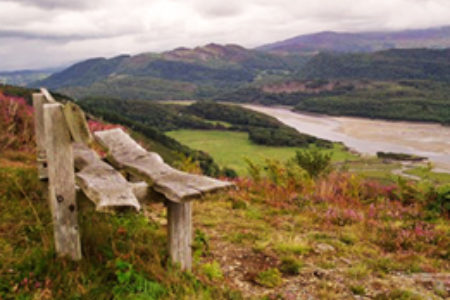Coed Lletywalter
Part of the Meirionnydd Oakwoods and Bat Sites SAC.
This wood is a designated Site of Special Scientific Interest and is part of the Meirionnydd Oakwoods and Bat Sites Special Area of Conservation. Oak trees clad in mosses and lichens shade a carpet, bluebell, bilberry, honeysuckle, sorrel and wood anemone in spring. Woodpeckers made the most of the many standing dead trees.
Coed Lletywalter is a substantial broadleaved woodland, well-connected within an extensive network of woods in the valleys stretching from Llanbedr to Cwm Bychan. Sessile oak is most abundant in the canopy, alongside birch and some sycamore. Beech, a tree not thought native to North Wales, was formerly abundant in parts of the wood, although this was largely removed during thinning operations in the 2000s. Ash is present on milder soils and alder and willow occupy wetter patches. The almost complete absence of old trees indicates substantial selected felling, perhaps during World War II.

The wood is extremely varied topographically, with cliffs, rocky knolls, streams, small glades and boulder strewn slopes. Mosses and liverworts carpet areas of the wood where boulders and rock outcrops are abundant. Bilberry heath has developed in places with bracken in more open parts of the wood. The ground flora reflects the predominantly acidic soils but enrichment in some areas increases the range of flowering plants to include wood anemone, wood false brome, dog’s mercury and tutsan. Bramble is locally abundant, particularly in areas where beech has been removed. Wetter areas introduce further diversity with species such as golden saxifrage and panicled sedge.

A small lake supports a range of wetland plants with stands of bottle sedge, common club rush and marsh cinquefoil. The site’s epiphytic lichen flora is somewhat under-developed, however, there is a population of tree lungwort around a historic abandoned small holding at Cwrt. The wood is ungrazed and this has allowed significant regeneration of young trees and shrubs, especially holly, which is locally abundant in the understorey. In recent years, woodland has expanded into former meadow areas within the northern half of the site, while there is evidence of similar processes occurring on adjacent bracken-dominated fields outside Woodland Trust ownership. The wood supports a breeding population of typical oak woodland birds.

Footer
For further details, enquires and comments please contact the Project Officers at
Telephone: 01766 770274
Email: post@celticrainforests.wales
Address:
Snowdonia National Park Authority,
National Park Office, Penrhyndeudraeth, Gwynedd. LL48 6LF
© 2019 - 2025 Celtic Rainforests Wales. All Rights Reserved
Subscribe to our Newsletter






